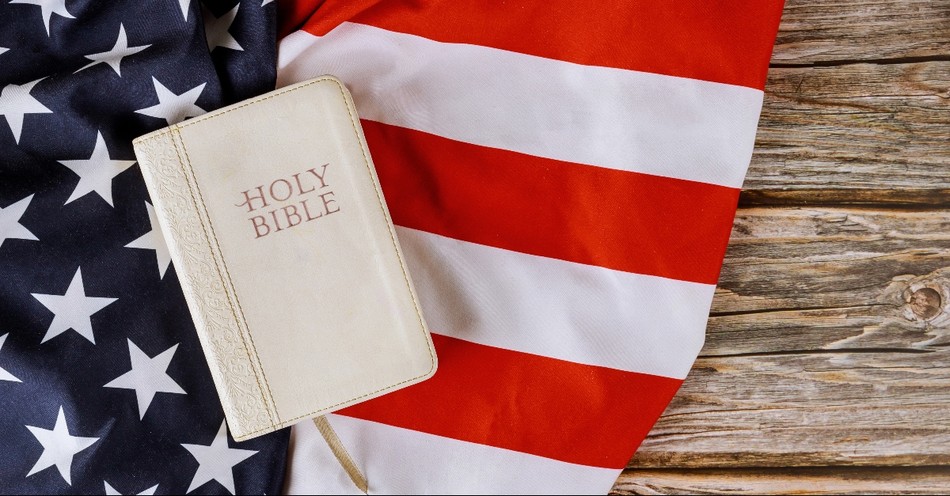This Fourth of July, the United States of America celebrated 244 years since the signing of the Declaration of Independence, the document that led to the American Revolutionary War and the eventual forming of the United States as a country.
Early Americans were a Bible-loving bunch, often immigrating to the Americas in order to pursue freedom of religion. Interestingly, however, a full English-language version of the Bible wasn’t printed in America until 1782.
Bibles Travel to America
The Geneva Bible was the first Bible brought to America, specifically to Plymouth, in 1620, and probably to Jamestown in 1607. This Bible, first published in 1560, was unique in that it had verse divisions, used smaller Roman type, was more compact, and had italicized words that were not in the original Greek or Hebrew, among other innovations.
The King James Version was first printed in 1611 in England, but it didn’t overtake the Geneva Bible in popularity in America until around the 1640s. Also in 1640, the first book printed in America, the Bay Psalm Book, was printed by Stephen Daye of Cambridge, Massachusetts. The Bay Psalm Book was not only the first book to be printed in America, but also the first partial version of the Bible to be printed there.
Early American Bibles
The first complete Bible of any sort to be published in America didn’t come along until 1663. John Eliot’s Algonquin-language translation of the Bible, the so-called “Eliot Indian Bible,” was the first Bible to be published in the Western Hemisphere.
Reverend John Eliot (1604-1690) arrived in Massachusetts Bay in 1631 and spent the rest of his life dedicated to serving as a missionary to the native people, earning him the title “Apostle to the Indians.” Eliot believed the indigenous population should be able to read the Bible in their own language. He began with a primer in 1654.
With the help of printers Marmaduke Johnson and Samuel Green and Native Americans John Nesutan, a Harvard-educated preacher, and “James Printer,” a man of the Nipmuc Tribe apprenticed to Samuel Green, Eliot produced the full Bible in the Massachusett language in 1663. The Bible was reprinted with corrections in 1685.
The first Bible in America to be published in a European language was printed in German by Christoph Saur in 1743. Twelve hundred copies of the first edition were produced, and Saur also published German New Testaments in 1745 and 1755. Saur’s son, Christoph Saur Jr., published a second Saur Bible in 1763 in an edition of 2,000 copies. The younger Saur’s printing business and his printing of Bibles and New Testaments were so successful that he became one of the wealthiest men in the colonies until he was accused of being a Loyalist in 1777 and was thus thrown in prison and his property was confiscated and auctioned off.
The Aitken Bible of 1782
Robert Aitken emigrated from Scotland to Philadelphia, Pennsylvania in 1769. He opened a bookshop and began “The Pennsylvania Magazine,” to which Thomas Payne often contributed. Starting in 1776, Aitken became the official printer of the Journals of Congress.
Aitken printed the New Testament in English in 1771, 1778, 1779, 1780, and 1781. Under the trade embargoes Britain had placed against the rebelling American colonies during this time, Aitken began to worry about Americans being able to acquire Bibles, which were previously imported from England.
On January 21, 1781, Aitken wrote to Congress,
“To the Honorable The Congress of the United States of America —
The Memorial of Robert Aitken of the City of Philadelphia, Printer
Humbly Sheweth
That in every well regulated Government in Christendom, The Sacred Books of the Old and New Testament, commonly called the Holy Bible, are printed and published under the Authority of the Sovereign Powers, in order to prevent the fatal confusion that would arise, and the alarming Injuries the Christian Faith might suffer from the spurious and erroneous editions of Divine Revelation ...
Under this persuasion your Memorialist begs leave to, inform your Honors that he both begun and made considerable progress in a neat edition of the Holy Scriptures for the use of schools, but being cautious of suffering his copy of the Bible to issue forth without the sanction of Congress, humbly prays that your Honors would take this important matter into serious consideration & would be pleased to appoint one Member or Members of your Honorable Body to inspect his work so that the same may be published under the Authority of Congress.”
Though Congress did not fund Aitken’s printing, it did authorize the project, and upon its completion, the two Chaplains of Congress approved Aitken’s Bible. Thus, Congress officially declared its endorsement of the Aitken Bible, the first and only time Congress has ever endorsed a version of the Bible.
Though this may seem a strange request from Aitken, the reality of the times was that England had previously forbidden the printing of English-language Bibles in the Americas in order to give a monopoly to the British printers licensed by the Crown. Aitken recognized Congress as the new ruling body of the Americas, and thus addressed his request to them.
Thus, in 1782, the first English version of the Bible was printed in America.
Other Firsts for American Bibles
From then on, more and more Bibles were printed in America, without regulation by the government as there had previously been.
Matthew Carey and William Young produced the first Roman Catholic English American edition in 1790.
Charles Thomson studied the Septuagint and produced the first translation of the Septuagint into English, which was also the first new English translation of the Bible in the Western Hemisphere. He published it in association with Robert Aitken’s daughter, Jane Aitken, in 1808, making her the first woman to ever print an edition of the Bible, and the first publisher of a new English translation of the Bible since the printing of the King James Version nearly two centuries before.
The first Hebrew Bible was printed in America in 1814, followed by the first French version in 1815, and the first Spanish version in 1824.
Today, there are hundreds of English translations of the Bible available in America. As the United States celebrates freedom from Britain this July, may we all celebrate our freedom in Christ.
Further Reading:
“The Bibles of Colonial America” from The Bible Museum, Inc.
“America’s Early Bibles” from The International Society of Bible Collectors
Photo Credit: ©iStock/Getty Images Plus/photovs




_639003522088907085.jpg)